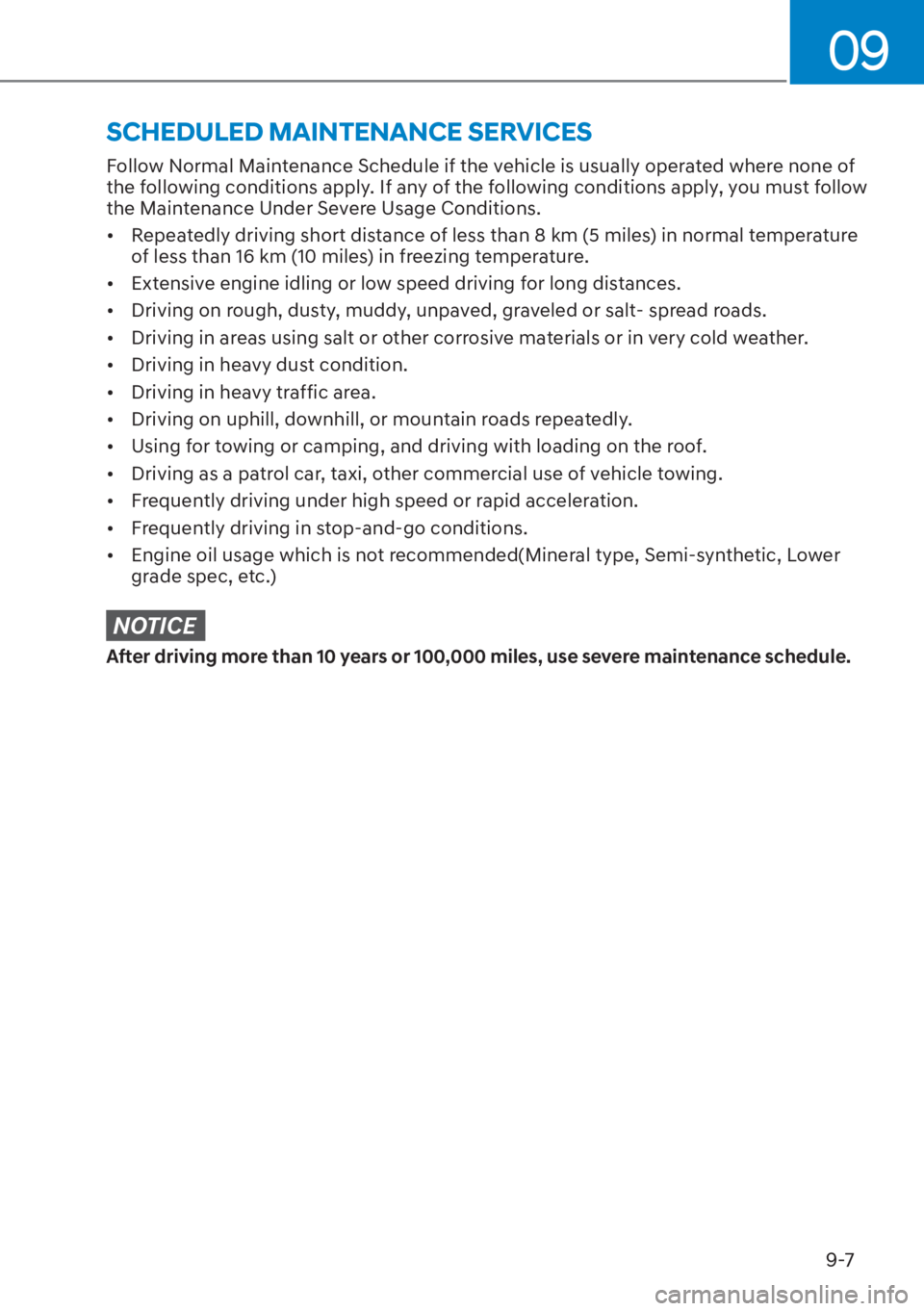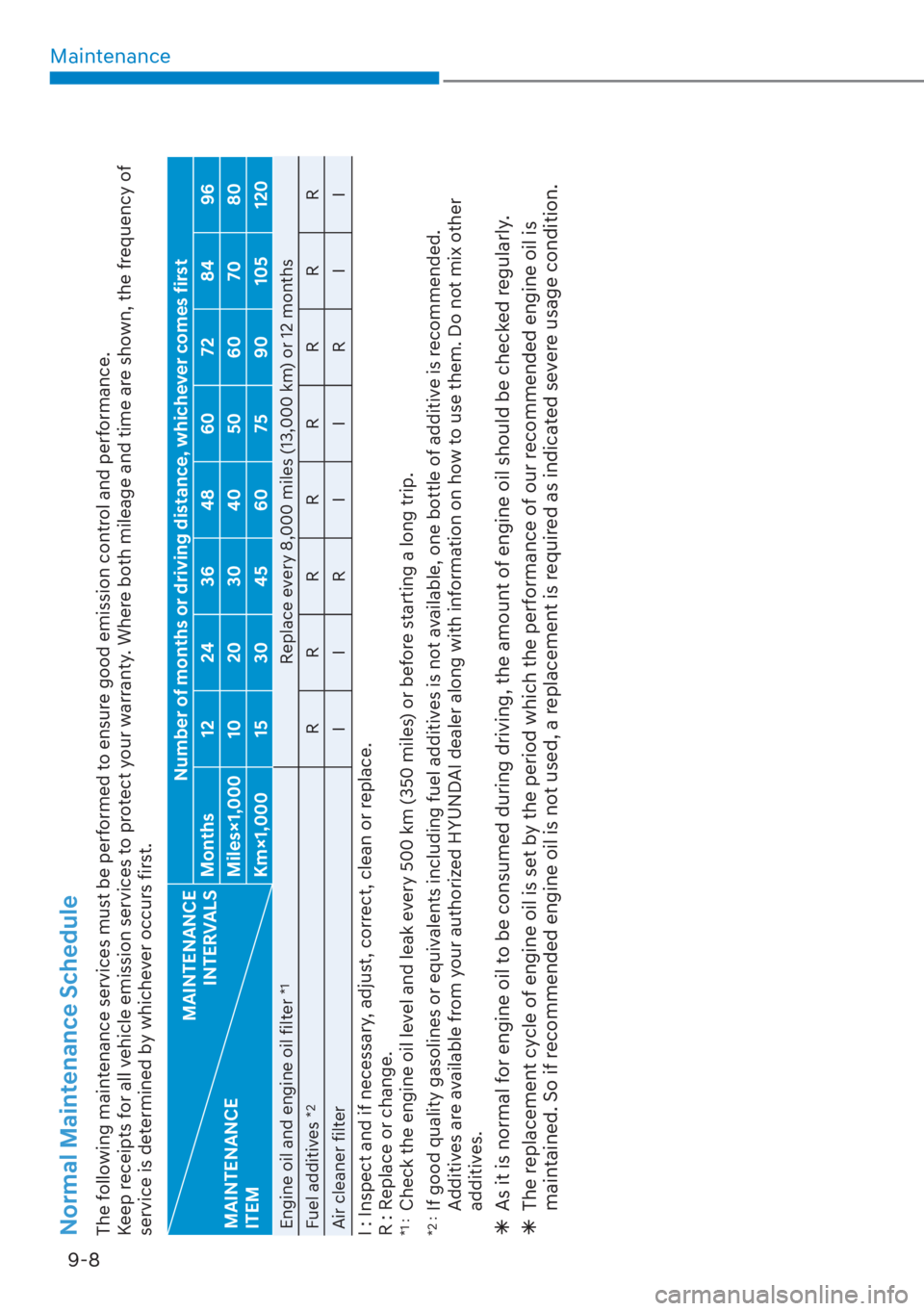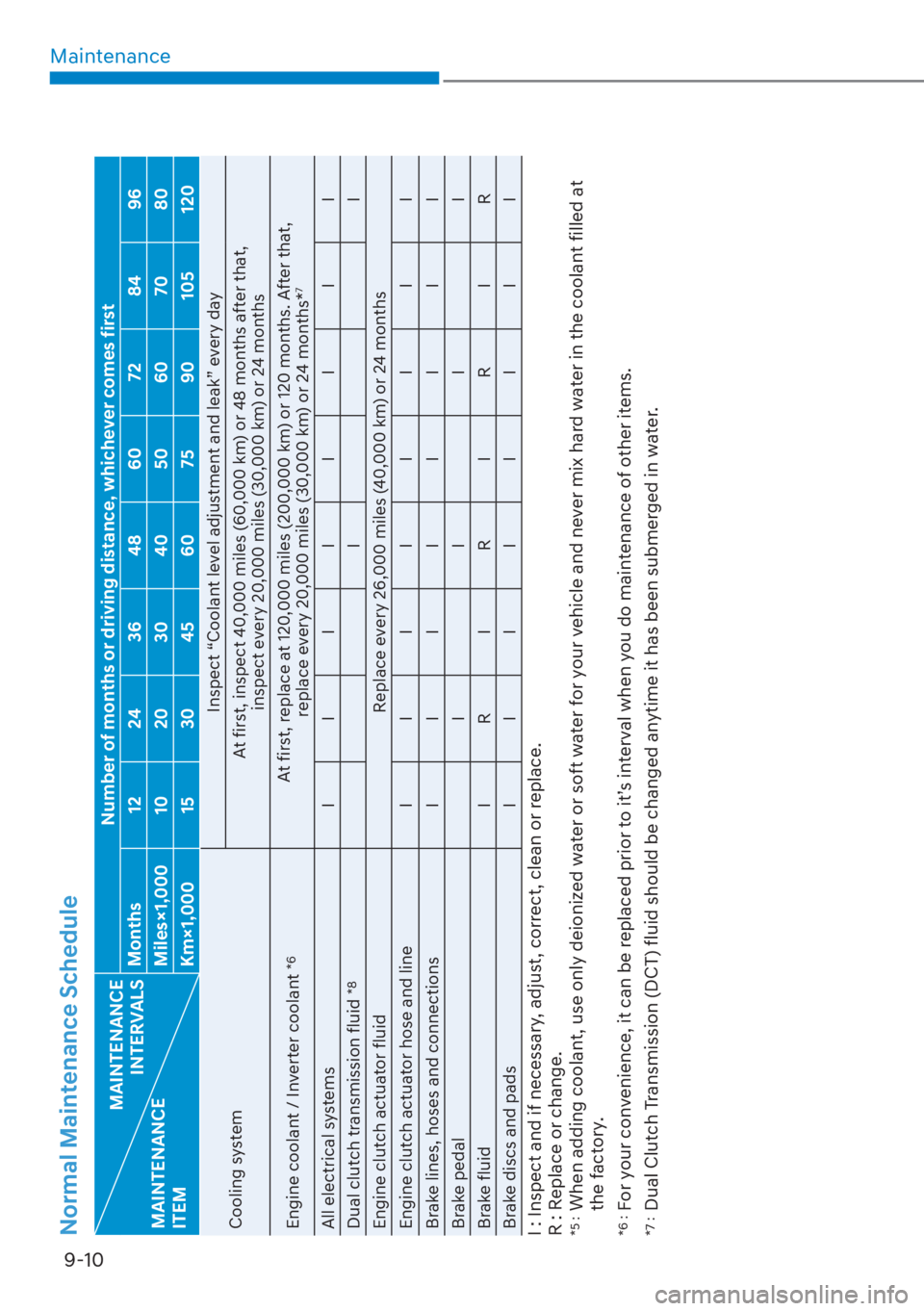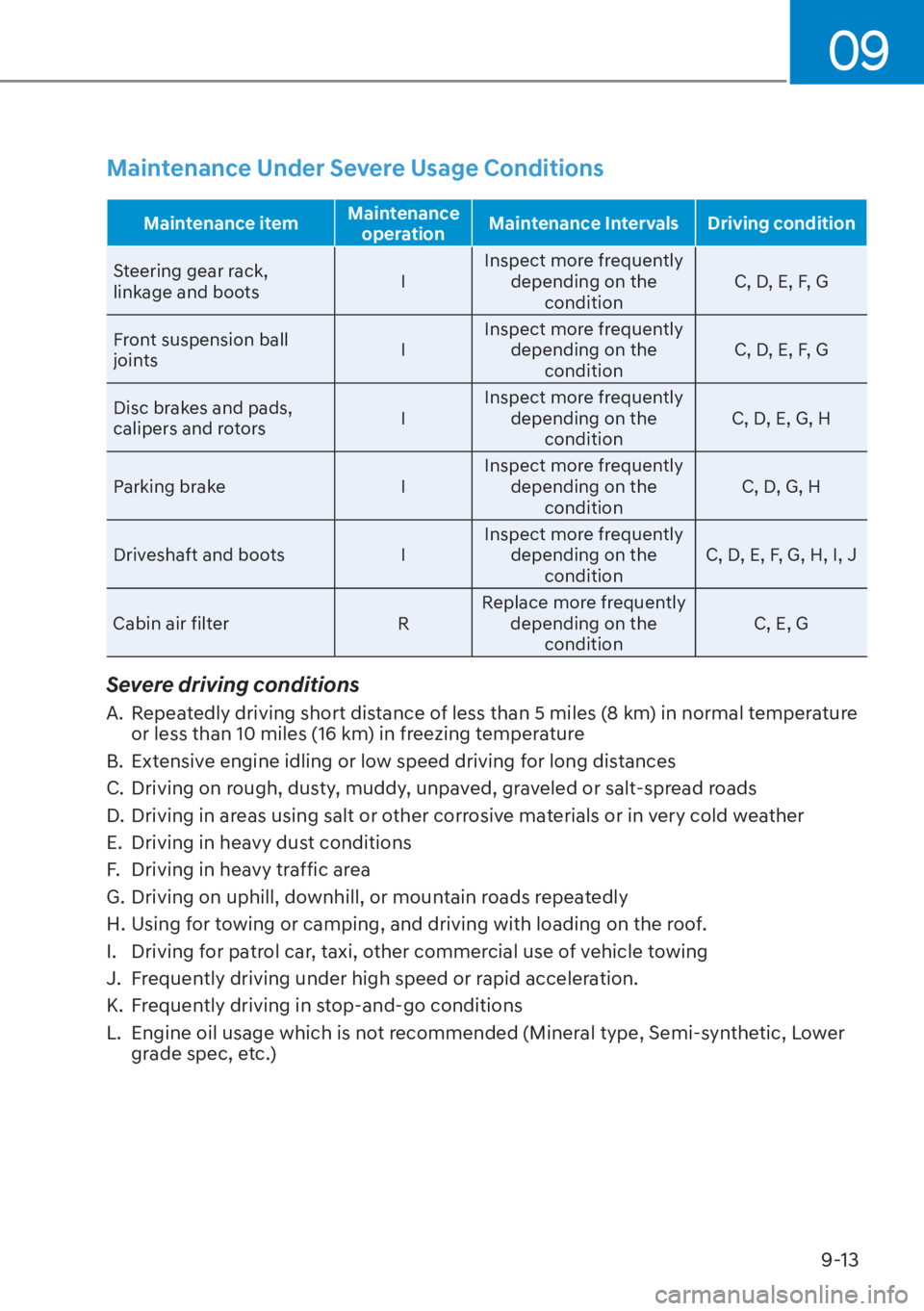Page 475 of 543

09
9-7
Follow Normal Maintenance Schedule if the vehicle is usually operated where none of
the following conditions apply. If any of the following conditions apply, you must follow
the Maintenance Under Severe Usage Conditions.
�[��Repeatedly driving short distance of less than 8 km (5 miles) in normal temperature
of less than 16 km (10 miles) in freezing temperature.
�[�� Extensive engine idling or low speed driving for long distances.
�[�� Driving on rough, dusty, muddy, unpaved, graveled or salt- spread roads.
�[�� Driving in areas using salt or other corrosive materials or in very cold weather.
�[�� Driving in heavy dust condition.
�[�� Driving in heavy traffic area.
�[�� Driving on uphill, downhill, or mountain roads repeatedly.
�[�� Using for towing or camping, and driving with loading on the roof.
�[�� Driving as a patrol car, taxi, other commercial use of vehicle towing.
�[�� Frequently driving under high speed or rapid acceleration.
�[�� Frequently driving in stop-and-go conditions.
�[�� Engine oil usage which is not recommended(Mineral type, Semi-synthetic, Lower
grade spec, etc.)
NOTICE
After driving more than 10 years or 100,000 miles, use severe maintenance schedule.
SCHEDULED MAINTENANCE SERVICES
Page 476 of 543

Maintenance9-8
Normal Maintenance Schedule The following maintenance services must be performed to ensure good emission control and performance.
Keep receipts for all vehicle emission services to protect your warranty. Where both mileage and time are shown, the frequency of
service is determined by whichever occurs first.
MAINTENANCE INTERVALS
MAINTENANCE
ITEM Number of months or driving distance, whichever comes first
Months 12 24 36 48 60 72 84 96
Miles×1,000 10 20 30 40 50 60 70 80
Km×1,000 15 30 45 60 75 90 105 120
Engine oil and engine oil filter
*1
Replace every 8,000 miles (13,000 km) or 12 months
Fuel additives
*2
RRRRRRRR
Air cleaner filter I I R I I R I I
I : Inspect and if necessary, adjust, correct, clean or replace.
R : Replace or change.*1 :
Check the engine oil level and leak every 500 km (350 miles) or before starting a long trip.
*2 :
If good quality gasolines or equivalents including fuel additives is not available, one bottle of additive is recommended.
Additives are available from your authorized HYUNDAI dealer along with information on how to use them. Do not mix other
additives.
�à As it is normal for engine oil to be consumed during driving, the amount of engine oil should be checked regularly.
�à The replacement cycle of engine oil is set by the period which the performance of our recommended engine oil is
maintained. So if recommended engine oil is not used, a replacement is required as indicated severe usage condition.
Page 478 of 543

Maintenance9-10
Normal Maintenance Schedule
MAINTENANCE INTERVALS
MAINTENANCE
ITEM Number of months or driving distance, whichever comes first
Months 12 24 36 48 60 72 84 96
Miles×1,000 10 20 30 40 50 60 70 80
Km×1,000 15 30 45 60 75 90 105 120
Cooling system Inspect “Coolant level adjustment and leak” every day
At first, inspect 40,000 miles (60,000 km) or 48 months after that, inspect every 20,000 miles (30,000 km) or 24 months
Engine coolant / Inverter coolant
*6
At first, replace at 120,000 miles (200,000 km) or 120 months. After that, replace every 20,000 miles (30,000 km) or 24 months*
7
All electrical systems I I I I I I I I
Dual clutch transmission fluid
*8
II
Engine clutch actuator fluid Replace every 26,000 miles (40,000 km) or 24 months
Engine clutch actuator hose and line I I I I I I I I
Brake lines, hoses and connections I I I I I I I I
Brake pedal IIII
Brake fluid I R I R I R I R
Brake discs and pads I I I I I I I I
I : Inspect and if necessary, adjust, correct, clean or replace.
R : Replace or change.*5 :
When adding coolant, use only deionized water or soft water for your vehicle and never mix hard water in the coolant filled at
the factory.
*6 :
For your convenience, it can be replaced prior to it’s interval when you do maintenance of other items.
*7 :
Dual Clutch Transmission (DCT) fluid should be changed anytime it has been submerged in water.
Page 480 of 543
Maintenance9-12
Maintenance Under Severe Usage Conditions
The following items must be serviced more frequently on cars mainly used under severe
driving conditions. Refer to the chart below for the appropriate maintenance intervals.
R : Replace
I : Inspect and if necessary, adjust, correct, clean or replace
Maintenance item Maintenance
operation Maintenance Intervals Driving
condition
Engine oil and engine oil filter R R
eplace every 3,750
miles (6,000 km) or 6 months A, B, C, D, E, F,
G, H, I, J, K, L
Air cleaner filter RReplace more
frequently depending on the condition C, E
Spark plugs RReplace more
frequently depending on the condition A, B, F, G, H,
I, K
HSG (Hybrid Starter &
Generator) belt R
Every 30,000 miles
(48,000 km) or 24 months B, C, D, E, I, K
I Every 5,000 miles
(8,000 km) or 6 months
Dual clutch transmission fluid R Every 80,000 miles
(120,000 km) C, D, E, F, G,
H, I, J
Page 481 of 543

09
9-13
Maintenance Under Severe Usage Conditions
Maintenance itemMaintenance
operation Maintenance Intervals Driving condition
Steering gear rack,
link
age and boots IInspect more frequently
depending on the condition C, D, E, F, G
Front suspension ball
joints IInspect more frequently
depending on the condition C, D, E, F, G
Disc brakes and pads,
calipers and rotors IInspect more frequently
depending on the condition C, D, E, G, H
Parking brake I Inspect more frequently
depending on the condition C, D, G, H
Driveshaft and boots I Inspect more frequently
depending on the condition C, D, E, F, G, H, I, J
Cabin air filter R Replace more frequently
depending on the condition C, E, G
Severe driving conditions
A. Repeatedly driving short distance of less than 5 miles (8 km) in normal temperature
or less than 10 miles (16 km) in freezing temperature
B. Extensive engine idling or low speed driving for long distances
C. Driving on rough, dusty, muddy, unpaved, graveled or salt-spread roads
D. Driving in areas using salt or other corrosive materials or in very cold weather
E. Driving in heavy dust conditions
F. Driving in heavy traffic area
G. Driving on uphill, downhill, or mountain roads repeatedly
H. Using for towing or camping, and driving with loading on the roof.
I. Driving for patrol car, taxi, other commercial use of vehicle towing
J. Frequently driving under high speed or rapid acceleration.
K. Frequently driving in stop-and-go conditions
L. Engine oil usage which is not recommended (Mineral type, Semi-synthetic, Lower grade spec, etc.)
Page 482 of 543

Maintenance9-14
Engine Oil and Filter
The engine oil and filter should be
changed at the intervals specified in the
maintenance schedule. If the vehicle
is being driven in severe conditions,
more frequent oil and filter changes are
required.
Drive Belts
Inspect all drive belts for evidence
of cuts, cracks, excessive wear or oil
saturation and replace if necessary. Drive
belts should be checked periodically
for proper tension and adjusted as
necessary.
Fuel Filter
A clogged-up fuel filter may limit the
vehicle driving speed, damage the
emission system, and cause the hard
starting. When a considerable amount
of foreign substances are accumulated
in the fuel tank, the fuel filter should be
replaced.
Upon installing a new fuel filter, operate
the engine for several minutes, and
check the connections for any leakages.
Fuel filters should be installed by an
authorized HYUNDAI dealer.
HSG (Hybrid Starter & Generator)
Belt
The HSG belt should be changed at the
intervals specified in the maintenance
schedule.
Fuel Lines, Fuel Hoses and
Connections
Check the fuel lines, fuel hoses and
connections for leakage and damage.
Have an authorized HYUNDAI dealer
replace any damaged or leaking parts
immediately.
Vapor Hose and Fuel Filler Cap
The vapor hose and fuel filler cap should
be inspected at those intervals specified
in the maintenance schedule. Make sure
a new vapor hose or fuel filler cap is
correctly replaced.
Air Cleaner Filter
A genuine HYUNDAI air cleaner filter
is recommended when the filter is
replaced.
Spark Plugs
Make sure to install new spark plugs of
the correct heat range.
When assembling parts, be sure to
wipe out foreign substances inside
and outside of the boot bottom of the
ignition coil and the insulator of the
spark plug with a soft cloth to prevent
contamination of the spark plug
insulator.
Cooling System
Check cooling system components, such
as radiator, coolant reservoir, hoses and
connections for leakage and damage.
Replace any damaged parts.
EXPLANATION OF SCHEDULED MAINTENANCE ITEMS
Page 483 of 543

09
9-15
Engine Coolant/Inverter Coolant
The coolant should be changed at the
intervals specified in the maintenance
schedule.
Dual Clutch Transmission Fluid
Dual clutch transmission fluid should
not be checked under normal usage
conditions.
We recommend that the Intelligent
variable transmission fluid is changed by
an authorized HYUNDAI dealer according
to the maintenance schedule.
Brake Hoses and Lines
Visually check for proper installation,
chafing, cracks, deterioration and any
leakage. Replace any deteriorated or
damaged parts immediately.
Brake Fluid
Check the brake fluid level in the brake
fluid reservoir. The level should be
between the MIN and the MAX marks
on the side of the reservoir. Use only
hydraulic brake fluid conforming to DOT
4 specification..
Brake Discs, Pads, Calipers and
Rotors
Check the pads for excessive wear, discs
for run out and wear, and calipers for
fluid leakage.
Suspension Mounting Bolts
Check the suspension connections for
looseness or damage. Retighten to the
specified torque.
Steering Gear Box, Linkage &
Boots/Lower Arm Ball Joint
With the vehicle stopped and the engine
off, check for excessive freeplay in the
steering wheel. Check the linkage for
bends or damage. Check the dust boots
and ball joints for deterioration, cracks,
or damage.
Replace any damaged parts.
Drive Shafts and Boots
Check the drive shafts, boots and clamps
for cracks, deterioration, or damage.
Replace any damaged parts and, if
necessary, repack the grease.
Air Conditioning Refrigerant
Check the air conditioning lines and
connections for leakage and damage.
Page 484 of 543
Maintenance9-16
Checking the Engine Oil Level
Engine oil is used for lubrication and
cooling, so it is gradually consumed
during driving the vehicle.
Regularly check and manage the oil level
using the following procedure.
1. Follow all of the oil manufacturer’s precautions.
2. Be sure the vehicle is on the level ground in P (Park) with the parking
brake set. If possible, block the
wheels.
3. Turn the engine on and allow the engine to reach normal operating
temperature.
4. Turn the engine off and wait about 15 minutes (with oil filler cap and dipstick
detached) for the oil to return to the
oil pan.
5. Pull the dipstick out, wipe it clean, and re-insert it fully.
OCN7H090003
6. Pull the dipstick out again and checkthe level.
OCN7H090004
7. If the oil level is below L, add enoughoil to bring the level to F.
Use only the specified engine oil. (refer
to “Recommended Lubricants and
Capacities” in chapter 2).
ENGINE OIL